#western toad tadpoles
Photo

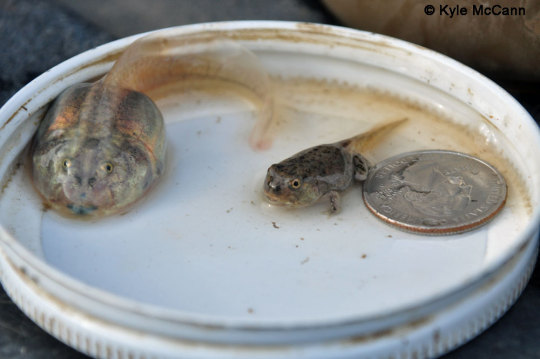
Who doesn’t love a chubby baby? Here we see two specimens of western spadefoot toad [Spea hammondii], both tadpoles at different stages of development. It’s a race against the clock for this desert dwelling species, which has to complete development before their temporary breeding pond dries up. Tadpoles take around 30 to 80 days to morph into frogs, but higher temperatures accelerate this process. Images by Kyle McCann.
#western spadefoot toad#spadefoot toad#spadefoot#toad#frog#herps#amphibians#animals#nature#tadpole#froglet#toadlet
891 notes
·
View notes
Photo

#photographers of tumblr#photographers on tumblr#lensblr#photography#original photographers#bay area#norcal#california#may#spring#animals#cute#tadpole#western toad#aesthetic#nature
5 notes
·
View notes
Photo
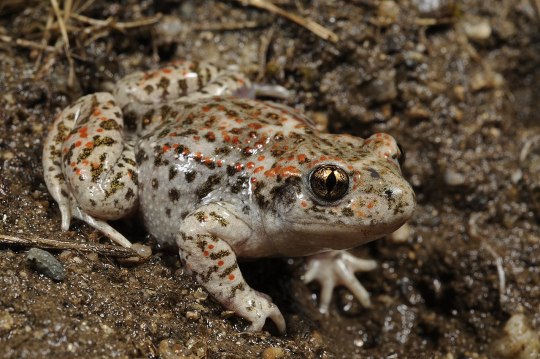

Midwife Toads (genus Alytes)
Midwife toads are a genus (Alytes) of frogs in the family Alytidae (formerly Discoglossidae), and are found in most of Europe and northwestern Africa.
Characteristic of these toad-like frogs is their parental care; the males carry a string of fertilised eggs on their backs, hence the name "midwife". The female expels a strand of eggs, which the male fertilizes externally. He then wraps them around his legs to protect them from predators in the water. When they are ready to hatch, the male wades into shallow water, where he allows the tadpoles to leap out of their eggs.
Five separate species of midwife toads are found across western Europe, northern Africa, and Majorca.
Midwife toads can be found in the snows of the Pyrenees, living at heights of 5,000–6,500 feet in areas such as the Néouvielle massif. Unlike the thin tongue of many amphibians, the midwife's tongue is round and flattened; its former family name, Discoglossidae, means "round tongue". In parts of France, midwife toads live in sand dunes by the sea...
Read more: https://en.wikipedia.org/wiki/Midwife_toad
photos: Iberian Midwife Toad by Benny Trapp CC and Common Midwife Toad by Christian Fischer CC
321 notes
·
View notes
Text
Today we went exploring in the mountains and had just about the best walk ever!

Western green lizard (lacerta bilineata). This guy was hiding under someone's post box and licked my finger.
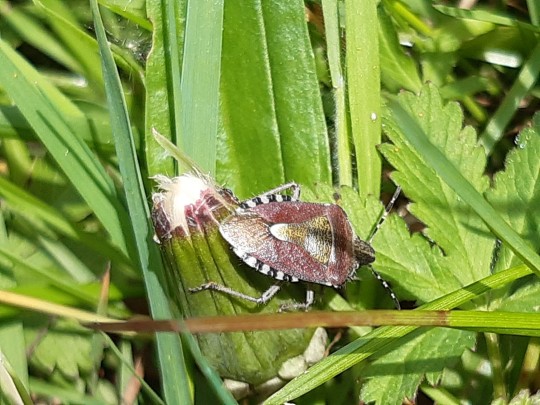


sloe bug (dolycoris baccarum), orange tip (anthocharis cardamines), black and red bug (lygaeus equestris)





Fire salamander (salamandra salamandra) neonates in different stages of development and a midwife toad (alytes obstetricians) tadpole (cannot emphasise enough how BIG these are, they are SO BIG)
There were also a lot of caddisfly larvae, some tiger beetles, and an interesting pillbug with yellow spots!
3 notes
·
View notes
Text
For most people, discovering a frog living in your fence post would make you feel either kind of creeped out or kind of charmed. For one guy in Australia, it was a challenge: He decided to make it the sweetest pad possible. In a now-viral two-minute TikTok video, he designs and 3-D-prints his frog an elaborate home. He keeps adding features until the lucky amphibian has an attached pool, a downstairs mating pond with a tadpole ramp, and a predator-proof safe room.
This frog house was gleefully over the top, practically engineered to go viral with its renovations for “increased ribbit amplification” and a brushtail possum who occasionally likes to drink water from the pool. But frog houses as an idea are worth taking seriously. Animals don’t need much to get cozy in our backyards and balconies, as the world has already learned with birds. One ecologist found that bird feeding goes back at least 3,500 years; in the 18th century, the facades of Ottoman palaces and mosques were fitted with structures to house birds, who were seen as both holy and lucky. Birdhouses and bird feeders are so thoroughly part of human culture that purple martins in eastern North America nest almost exclusively in houses made by humans.
But why do birds get all the love? Building a little house for a frog to shelter in, or a pond where eggs can hatch and tadpoles can grow, is a great idea if you’ve got a place to put it. Even a tiny pondlet in a container on a patio can raise a whole amphibian generation. You can provide meaningful help to animals that need it, and participate in species conservation at home with very few downsides. Honestly, creating a backyard pond is probably better than putting up a birdhouse. Will someone please think of the urban amphibian?
Birds are beautiful, and they sing—it is no wonder we have long welcomed them into human spaces. At some level, it doesn’t even feel like sharing space, because birds live up high, in trees and on rooftops and telephone wires. They get the sky, and we get the land. Seems fair. But frogs? Inviting them into the garden can make you feel uneasy. Whereas birds are “so obvious and so charismatic,” Erin Sauer, an ecologist at the University of Arkansas who has studied both urban birds and urban amphibians, told me, frogs are “cryptic” and “camouflaged”—“they don't want you to find them.” Many frogs in temperate zones, including much of the United States, are brown and green, and more active at night. They are a subtle pleasure, compared with a crimson cardinal or an iridescent hummingbird.
It might not be obvious that some amphibians are probably living not too far from you, in part because they stay hidden. Frogs, newts, and salamanders exist in most cities. In New York, you can hear gray tree frogs call in Brooklyn Heights. In Los Angeles, the canyons of Griffith Park are filled with bumpy western toads. According to the biodiversity tracker iNaturalist, 28 species of amphibians have been spotted in Columbus, Ohio, including the colorful eastern red-backed salamander.
But amphibian populations are declining. Forty-one percent of amphibians are threatened with extinction, in part because of an ongoing fungal pandemic that as of four years ago had driven an estimated 90 species extinct. Frogs also have habitat needs that are “so specific,” Sauer said: They must have both water and land to complete their life cycle.
Still, if there are frogs near your home and some relatively protected route for them to travel, and you build a pond with vegetation around it, they will likely move in. An analysis of dozens of projects that created ponds for amphibians found that in every study, frogs showed up at some or all of the ponds. And many of the studies found that the number of species was similar or higher in created ponds than in natural ponds. Not all of those ponds were in cities, but another study looked at ponds in Portland, Oregon, and found similar results. The biggest predictor of how well a pond attracted frogs wasn’t whether it was real or fake, but the amount of plants growing in and around it.
Frog ponds aren’t very common residential features (yet), but it isn’t like no one thinks of amphibian-kind when designing their outdoor space. The U.S. Department of Agriculture has some advice for creating effective backyard conservation ponds for native wildlife. There are any number of guides online to building toad abodes, frog hotels, and general-purpose backyard frog ponds. Some gardeners install toad houses, hoping that a toad will move in and pay rent by eating common garden pests. You can even buy handmade toad houses on Etsy. And naturally, TikTok Frog House Guy is now selling frog houses as well.
It can be simple, and cheap, to invite amphibians over to your place. Tree frogs love to hang out inside vertical tubes, so simply pounding a few PVC pipes into the ground can create a little frog hotel. Building a cozy house for toads can be as easy as half-burying a broken pot. Making a frog pond is as straightforward as digging a hole; setting a commercial pond liner, an old bathtub, or even a plastic storage tote in the hole; and filling it with rocks and water. “You don’t need to 3-D-print some elaborate frog mansion,” Sauer told me.
I had called Sauer to set my mind at ease on one point: Would creating an artificial house or pond also create a transmission point for disease? She told me it wasn’t worth worrying about. Yes, multiple frogs might move into a pond or house, and they might touch if they mate, but frogs already gather in groups naturally, whereas birds at bird feeders can congregate in unusually high numbers. Feeders can pose a disease risk to birds, Sauer said: “You have a single place with one porthole, and they stick their faces in there and chew on things. And then their friends come over and do the same thing.” A frog pond can even bring in birds, who will use it to bathe and drink—with less chance of disease transmission.
There are very few downsides to catering to your local frogs, the biggest of which is that your backyard might have more mosquitoes—mosquitoes, like frogs, breed in water. To avoid that, you either need animals that will eat all of the mosquitoes (such as dragonflies or some tadpoles) or you need to keep the water moving. A solar-powered aerator costs about $30.
It is very possible that the frogs that show up to your patio water feature won’t be critically endangered species, but that’s okay. “We want to keep common species common so they don’t decline,” Sauer said. It all helps. Providing habitat for amphibians is important, but researchers are also working on frog houses that will actually help save frogs from the fungal pathogen. These houses would be like little greenhouses: hot enough to kill the fungus but not too hot for the frog’s comfort.
Not everyone can or wants to build a frog house. But they might be interested in putting a pot full of wildflowers for pollinators on their balcony. Saving species in the 21st century isn’t just about protecting big, undeveloped parks—although we need those too. It is also about figuring out how to coexist with the many species that can thrive in the urban, suburban, exurban, and agricultural landscapes we’ve made. That we’ve shared space with birds for thousands of years proves we can do it.
There’s evidence that this is already happening, and birdhouses and frog houses are just the beginning. People are adding bee hotels and bat houses, and planting milkweed for endangered monarch butterflies to lay their eggs on. It can be dizzying to think about all the species that need help right now, but engaging in everyday conservation can also just be fun, helping to turn neighborhoods into corridors of habitat for creatures such as frogs. Our cities can be wetlands too, at least in spots. Our kids can watch tadpoles on summer days. And in the spring, we can listen to the frogs sing at dusk.
— You Should Build a Frog Pond
#emma marris#you should build a frog pond#environmentalism#ecology#wildlife conservation#history#animals#frogs#salamanders#newts#toads#gray treefrog#western toad#red-backed salamander#mosquitoes#dragonflies#ottoman empire#erin l. sauer
8 notes
·
View notes
Text
Kaisen Azuma
We gone over Kujiru last time, so it's time to go over their sworn rival and fellow shikigami under their master Garaiya Ogata:
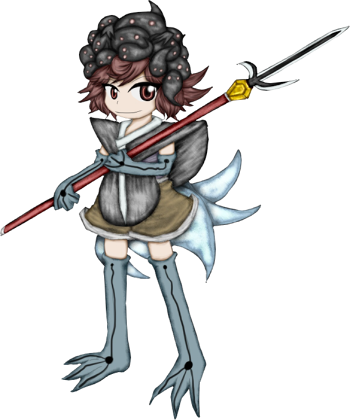
Three-legged Moon Seeker — Kaisen Azuma
Name
Their family name, Azuma (東), means "east", and is a common Japanese family name, specifically in western Japan and the Ryukyu Islands. In their given name, Kaisen (海仙), the characters mean "sea" (海) and "enlightened person" (仙).
The latter specifically refer to the xiān (仙) of Chinese conception, it refers to different things depending on the context, but most notably and relevant to us, are enlightened hermits that have achieved immortality and wield powerful magic, often Taoist in nature.
Title
Kaisen's title, the "Three-legged Moon Seeker" (月を仰ぐ三つの足), is technically the "Three Legs That Seek the Moon", to be direct, but this ordering is chosen to sound more poetic.
Additionally, we shout take a look at the verb ao-gu (仰ぐ), which has the following meanings:
(Physically) look up to
(Metaphorically) look up to; respect
Seek (for help, for knowledge, etc.)
Turn one's head upwards and drink in one gulp
Out of all four, 2 and 3 seem like the most likely meanings. as the moon seems to be a symbol for the "emperor" or even just "authority" in Mugenri/Len'en.
In the translation, 3 is chosen, likely because Kaisen didn't actually respect the "emperor" on their side of the war. In fact, Kaisen doesn't even agree with trusting Chouki as the new emperor, despite having personally trained them prior.
Species and Abilities
While Kaisen shares similarities with many other animal youkai, like having animal characteristics and being able to transform into an animal, they are technically a "sacred animal" (霊獣). However, what this means isn't exactly clear.
Kaisen is quite high in their overall abilities, they're a poerful fighter and have a number of abilities, including their knowledge of Taoist arts, ability to use shikigami of their own and their clairvoyance, though the accuracy can apparently be a bit lacking.
Their main ability, the one listed on their profile, is to "gather financial fortune". They are able to bless those who are lucky with fortune and happiness, upon other things, which is likely a manifestation of this ability.
As a shikigami, they are considered more powerful than Kujiru. Unfortunately, they require more spiritual energy to activate and activate their own shikigami in turn, this ends up being less efficient than Kujiru and leads to the latter being more convenient for Garaiya.
Mythological Bases
Kaisen actually a number of mythological bases, from both Chinese and Japanese sources, which make them a very interesting character, at least in my opinion. So let's take a look at them!
Jinchan, the Money Toad
Kaisen is predominantly based on a mythological Chinese creature known as Jinchan (金蟾 lit. "gold/golden/money toad"). It's a toad that has three legs, two front legs and one hind leg, which is positioned like a tadpole's tail at the back of the toad.
This is referenced in Kaisen only having three limbs, one of their legs we see in-game being a prosthetic, as well as in their title "Three-legged Moon Seeker".
Below: A Jinchan statue from the behind, used in Feng Shui to attract wealth to the household.

Jinchan is also related to the Chinese Taoist and legendary immortal Liu Haichan (劉海蟾). His first name translates to "sea toad" and is considered an embodiment of the Chinese God of Wealth.
In the folktale Liu Hai Tricks Jinchan (劉海戲金蟾), it is said Liu tamed a malevolent and greedy three-legged toad after fishing it out of the east sea with a string of coins.
It became Jinchan and was henceforth the immortal's companion, following Liu wherever he went. Kaisen's relationship with Garaiya may be a reference to this myth.
Below: Liu carrying the toad in his arm after fishing it out.

Additionally, it is said that Jinchan spewed treasure from its mouth with each step that it took after Liu, benefiting the poor wherever it went. This is likely referenced in Kaisen's ability to "gather financial fortune".
Gamma-sennin, the Toad Hermit
In Japan, Liu Haichan inspired the mythological Taoist immortal Gama-sennin (蝦蟇仙人 Lit. "Toad Taoist Immortal"), who in turn inspired parts of Kaisen's character.
Gama-sennin appears in the legends surrounding Taira no Yoshikado (平良門), the legendary hidden eldest son of Taira no Masakado who learns toad magic from the immortal and uses his powers in an attempt to avenge his father.
In the 17th century yomihon novel series "The Tale of Utou Yasutaka's Loyalty" (善知安方忠義伝) by Santō Kyōden, this teacher figure is instead a 3000-year old toad spirit named Nikushi-sen (肉芝仙) who lived on Mount Tsukuba (筑波山).
Below: Nikushi-sen (upper-centre) teaching Yoshikado (right of Nikushi-sen) toad magic.
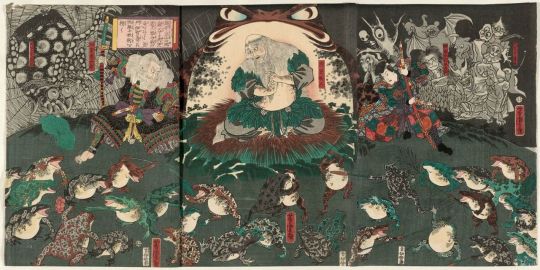
He taught toad magic to Yoshikado's sister Nyozou-ni (如蔵尼) as well, later possessing her to transform her into Takiyasha-hime (滝夜叉姫), whom Taira no Chouki is based on.
This would explain Kaisen having a part in training Chouki, as well as their spell card that reference Mt. Tsukuba, Leaping Medicine "Tsukuba Toad Oil". I should note that it's also a reference to a local cure-all from Mt. Tsukuba.
Seia-jin, the "Chinese" frog "god"
Gamma-sennin is said to command the youkai Seia-jin or Chinwa-sen (青蛙神 lit. "(green) frog god"), also simply known as Seia (青蛙 lit. "(green) frog), which plays a role similar to that of Jinchan. Indeed, despite having "god" in its name, it is but a youkai.
Both Seia-jin and Gamma-sennin are actually said to be "Chinese", but it's fairly certain that they are actually Japanese inventions.
Particularly, Seia-jin can be traced back to a Chinese novel of the same name, which tells of several tales related to the mythical beast. However, it was never worshipped as an actual deity in China.
It is said that the house that Seia-jin appears in front of will have its family blessed with financial fortune and happiness, this is again referenced in Kaisen's ability.
Summary: Taoist Hermit/Toad Familiar Pairs
It is in reality just as possible that JynX only based Kaisen on one of these Taoist hermit/toad familiar pairs, since the Chinese pair pretty heavily inspired the Japanese pair.
However, if I had to narrow it down, I'd actually say that Kaisen's based on the Chinese Jinchan but the Japanese Gamma-sennin. Only Jinchan is is said to have three legs, while Gamma-sennin's role in mentoring Taira clansmen parallels the story of Len'en directly.
It's just as possible that these two are what JynX ultimately ended up focusing on, but given the intertwined nature of these four it would realistically be impossible to pinpoint unless we learn more about Kaisen, or even get a direct answer from JynX.
No matter what the truth really is, the idea behind Kaisen's main inspiration should be clear enough.
Bonus: The "Lunar Spirit"
Here we get into slightly shakier territory: I believe that Kaisen may also be inspired by the Chinese concept of the "lunar spirit" (月精), the spiritual essence of the moon.
There are three major candidates as to who this spirit is, the Chinese Moon Rabbit (月兔), the dark parts of the moon, the moon goddess Chang'e (嫦娥) and an unspecified toad, the light parts of the moon.
Below: A bronze mirror depicting Chang'e (left), the moon rabbit (right) and the toad (bottom-center) surrounding a sweet osmanthus on the moon.
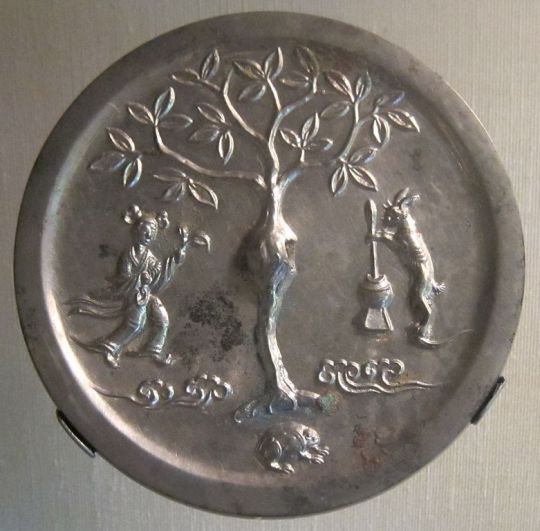
This toad is sometimes said to be what Chang'e transformed into after flying to the moon, but modern Feng Shui instead equates the lunar toad with Jinchan. This may explain why Kaisen is called the "Moon Seeker" in their title.
The concept of the lunar essence is believed to have arisen as the counterpart to the "solar essences" (日之精), the "three-legged crows" (三足烏) that lived in the suns (multiple because Chinese mythology tells that there used to be 10 of those).
When spread to Japan, these three-legged crows fused with the divine messenger bird of the Shinto sun goddess Amaterasu, the Yatagarasu (八咫烏), who is sometimes said to be the sun itself.
If the lunar spirit is extended to be the counterpart of the Yatagarasu as well, this may explain Kaisen's status as a "sacred animal".
Minor Theory: Kaisen's Role
I have a small theory on Kaisen's role as a sacred animal based on the idea that the lunar toad could be extended to be the counterpart of the Yatagarasu.
Let's first learn more about the Yatagarasu: In Japanese mythology, it is most famously the divine messenger bird of the sun goddess Amaterasu (or, depending on the source, Takagi-no-Kami, the second god to come into existence).
It was a gigantic bird who guided Kamuyamato Iwarebiko-no-Mikoto (神倭伊波礼琵古命) through the dangerous lands of Yamato to a suitable place to set up his government as the legendary 1st emperor of Japan, Emperor Jimmu (神武天皇).
Below: The Yatagarasu guiding Iwarebiko (center).
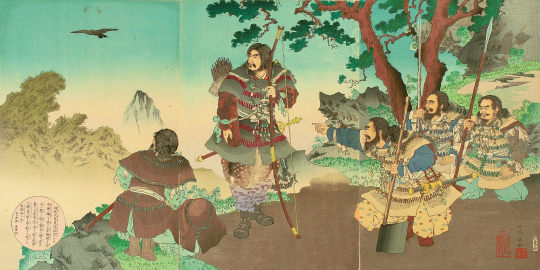
My theory is that perhaps Kaisen is a similar being, this time of the moon rather than the sun, a divine messenger sent to guide Mugenri's "true emperor".
This may explain why they are the "moon seeker", as well as why they were against following Chouki as the new emperor, as they may have a sense for who is meant to be, or at least suitable to be, the emperor of Mugenri.
Note: Tsukuyomi in Mugenri
If Kaisen truly is a sacred animal sent by some deity on the moon to guide Mugenri's "true emperor", it may be that they are in fact sent by the Shinto god of the moon, Tsukuyomi-no-Mikoto (月読命).
This ties quite neatly into this theory I had about the origins of Mugenri, particularly the bit near the end where I suggest that Tsukuyomi may be the god of Mugenri as a whole.
Tsukuyomi being the "supreme" god of Mugenri may also explain Mugenri's association between the moon and rulership, in opposition to the outside's sun as the symbol of authority, in Japan at least.
Additionally, the Japanese royal family, the one in reality I mean, trace their own ancestry back to the Shinto sun goddess Amaterasu.
Maybe a similar thing once happened or is meant to happen with Mugenri? Perhaps Kaisen's role is to look for a descendant of Tsukuyomi and guide them to become the emperor of Mugenri?
We obviously have no way of knowing right now, but it's a fun possibility to consider nevertheless.
Ending
And that's all I have on Kaisen! A lot of mythology and quite a bit of theory this time, but with such a mysterious character it is indeed quite fun to speculate a slight tad.
As usual, I hope you enjoyed~! :)
7 notes
·
View notes
Text
For most people, discovering a frog living in your fence post would make you feel either kind of creeped out or kind of charmed. For one guy in Australia, it was a challenge: He decided to make it the sweetest pad possible. In a now-viral two-minute TikTok video, he designs and 3-D-prints his frog an elaborate home. He keeps adding features until the lucky amphibian has an attached pool, a downstairs mating pond with a tadpole ramp, and a predator-proof safe room.
This frog house was gleefully over the top, practically engineered to go viral with its renovations for “increased ribbit amplification” and a brushtail possum who occasionally likes to drink water from the pool. But frog houses as an idea are worth taking seriously. Animals don’t need much to get cozy in our backyards and balconies, as the world has already learned with birds. One ecologist found that bird feeding goes back at least 3,500 years; in the 18th century, the facades of Ottoman palaces and mosques were fitted with structures to house birds, who were seen as both holy and lucky. Birdhouses and bird feeders are so thoroughly part of human culture that purple martins in eastern North America nest almost exclusively in houses made by humans.
But why do birds get all the love? Building a little house for a frog to shelter in, or a pond where eggs can hatch and tadpoles can grow, is a great idea if you’ve got a place to put it. Even a tiny pondlet in a container on a patio can raise a whole amphibian generation. You can provide meaningful help to animals that need it, and participate in species conservation at home with very few downsides. Honestly, creating a backyard pond is probably better than putting up a birdhouse. Will someone please think of the urban amphibian?
Birds are beautiful, and they sing—it is no wonder we have long welcomed them into human spaces. At some level, it doesn’t even feel like sharing space, because birds live up high, in trees and on rooftops and telephone wires. They get the sky, and we get the land. Seems fair. But frogs? Inviting them into the garden can make you feel uneasy. Whereas birds are “so obvious and so charismatic,” Erin Sauer, an ecologist at the University of Arkansas who has studied both urban birds and urban amphibians, told me, frogs are “cryptic” and “camouflaged”—“they don't want you to find them.” Many frogs in temperate zones, including much of the United States, are brown and green, and more active at night. They are a subtle pleasure, compared with a crimson cardinal or an iridescent hummingbird.
It might not be obvious that some amphibians are probably living not too far from you, in part because they stay hidden. Frogs, newts, and salamanders exist in most cities. In New York, you can hear gray tree frogs call in Brooklyn Heights. In Los Angeles, the canyons of Griffith Park are filled with bumpy western toads. According to the biodiversity tracker iNaturalist, 28 species of amphibians have been spotted in Columbus, Ohio, including the colorful eastern red-backed salamander.
But amphibian populations are declining. Forty-one percent of amphibians are threatened with extinction, in part because of an ongoing fungal pandemic that as of four years ago had driven an estimated 90 species extinct. Frogs also have habitat needs that are “so specific,” Sauer said: They must have both water and land to complete their life cycle.
Still, if there are frogs near your home and some relatively protected route for them to travel, and you build a pond with vegetation around it, they will likely move in. An analysis of dozens of projects that created ponds for amphibians found that in every study, frogs showed up at some or all of the ponds. And many of the studies found that the number of species was similar or higher in created ponds than in natural ponds. Not all of those ponds were in cities, but another study looked at ponds in Portland, Oregon, and found similar results. The biggest predictor of how well a pond attracted frogs wasn’t whether it was real or fake, but the amount of plants growing in and around it.
Frog ponds aren’t very common residential features (yet), but it isn’t like no one thinks of amphibian-kind when designing their outdoor space. The U.S. Department of Agriculture has some advice for creating effective backyard conservation ponds for native wildlife. There are any number of guides online to building toad abodes, frog hotels, and general-purpose backyard frog ponds. Some gardeners install toad houses, hoping that a toad will move in and pay rent by eating common garden pests. You can even buy handmade toad houses on Etsy. And naturally, TikTok Frog House Guy is now selling frog houses as well.
It can be simple, and cheap, to invite amphibians over to your place. Tree frogs love to hang out inside vertical tubes, so simply pounding a few PVC pipes into the ground can create a little frog hotel. Building a cozy house for toads can be as easy as half-burying a broken pot. Making a frog pond is as straightforward as digging a hole; setting a commercial pond liner, an old bathtub, or even a plastic storage tote in the hole; and filling it with rocks and water. “You don’t need to 3-D-print some elaborate frog mansion,” Sauer told me.
I had called Sauer to set my mind at ease on one point: Would creating an artificial house or pond also create a transmission point for disease? She told me it wasn’t worth worrying about. Yes, multiple frogs might move into a pond or house, and they might touch if they mate, but frogs already gather in groups naturally, whereas birds at bird feeders can congregate in unusually high numbers. Feeders can pose a disease risk to birds, Sauer said: “You have a single place with one porthole, and they stick their faces in there and chew on things. And then their friends come over and do the same thing.” A frog pond can even bring in birds, who will use it to bathe and drink—with less chance of disease transmission.
There are very few downsides to catering to your local frogs, the biggest of which is that your backyard might have more mosquitoes—mosquitoes, like frogs, breed in water. To avoid that, you either need animals that will eat all of the mosquitoes (such as dragonflies or some tadpoles) or you need to keep the water moving. A solar-powered aerator costs about $30.
It is very possible that the frogs that show up to your patio water feature won’t be critically endangered species, but that’s okay. “We want to keep common species common so they don’t decline,” Sauer said. It all helps. Providing habitat for amphibians is important, but researchers are also working on frog houses that will actually help save frogs from the fungal pathogen. These houses would be like little greenhouses: hot enough to kill the fungus but not too hot for the frog’s comfort.
Not everyone can or wants to build a frog house. But they might be interested in putting a pot full of wildflowers for pollinators on their balcony. Saving species in the 21st century isn’t just about protecting big, undeveloped parks—although we need those too. It is also about figuring out how to coexist with the many species that can thrive in the urban, suburban, exurban, and agricultural landscapes we’ve made. That we’ve shared space with birds for thousands of years proves we can do it.
There’s evidence that this is already happening, and birdhouses and frog houses are just the beginning. People are adding bee hotels and bat houses, and planting milkweed for endangered monarch butterflies to lay their eggs on. It can be dizzying to think about all the species that need help right now, but engaging in everyday conservation can also just be fun, helping to turn neighborhoods into corridors of habitat for creatures such as frogs. Our cities can be wetlands too, at least in spots. Our kids can watch tadpoles on summer days. And in the spring, we can listen to the frogs sing at dusk.
1 note
·
View note
Photo


Citizen Science is toad-ally cool!
Ongoing amphibian monitoring occurs at Mount Rainier National Park, where Citizen Science volunteers complete surveys alongside park staff. When visiting known breeding grounds, volunteers use Visual Encounter Surveys to collect information regarding the development of important species. The data collected follows amphibians from eggs until they metamorphose into juveniles.
Here, volunteers helped collect data on a species of special concern, the Western Toad. To learn more about Citizen Science amphibian monitoring at Mount Rainier visit https://go.usa.gov/xUMAB.
NPS/I. Metzen Photos. Description: (top) Three people stand on the edge of a pond holding nets, while one points out a frog in the water. (bottom) A toad larva with developed limbs and a tail is held up in a plastic bag filled with water. -im
#Mount Rainier National Park#mount rainier#MORAEmployees#national park service#citizen science#wildlife conservation#amphibians#western toad#tadpole#metamorphosis
13 notes
·
View notes
Photo



A Time with the Natterjack Toad
The natterjack toad (Epidalea calamita) is a small species of toad endemic to Western Europe, including the Iberian peninsula and the British Isles-- in fact, it is the only toad native to Ireland. It thrives in warm ponds and sand dunes, but it can also be found in coastal marshes and urban areas with plenty of moisture and food. They are nocturnal, and during the day they will hide under leaf litter, rocks, or in mud or sand.
Natterjack toads tend to run on the smaller end of the scale, with a length of 8-10cm and a weight of 10-15g; females tend to be larger than males. They are usually brown or greenish in color, which, when combined with their bumpy backs, gives them excellent camouflage skills. However, E. calamita can be distinguished from the common toad by the prominent yellow stripe running down their backs. Their legs are short and stubby, unlike those of their frog cousins, and they are far more suited to crawling than they are jumping or swimming.
Although they are naturals when it comes to blending in, the natterjack toad has one very distinctive feature that singles it out: its mating call. Mating occurs during the spring, and males will call loudly in competition with one another for females. At its peak, and single natterjack toad can be heard from over 2km away. When a mate has been attracted, the male-- or sometimes several competitors-- will mount the female. Afterwards the female lays up to 3,000 eggs in long strings, not unlike a pearl necklace. These eggs require warm, shallow, freshwater to hatch properly-- pools that fit this description are often temporary and dry up in the heat of summer, so individuals will also compete loudly for available space. The eggs hatch after about a week, and tadpoles continue to develop until the fall when they reach their adult stage.
Adult natterjack toads, like many other toads, are insectivores. They particularly go after moths and spiders, although they are also known to eat other invertebrates like worms and snails. Tadpoles feed on algae and vegetation until they are about a month old. In turn, tadpoles are often prey to fish, larger amphibians, and birds, while adults can fall prey to cats, foxes, or birds like crows, hawks, and owls.
Conservation status: Although they have not been evaluated by the IUCN, the natterjack toad is considered highly endangered in the UK and Ireland, and threatened in continental Europe. In the British Isles there are only six known colonies, whereas it is more widespread throughout the rest of Europe. In both areas its primary threat is habitat loss, as it requires warm, shallow pools with specific inclines and vegetation in order to reproduce. They are also affected by pesticides and chytrid fungus infections. Currently it is illegal in Europe to capture, injure, or kill natterjack toads, and breeding and reintroduction programs are under way to conserve the species.
Photos
Bernard Dupont
Matt Wilson
Frank Vassen
#natterjack toad#anura#bufonidae#true toads#toads#amphibians#coasts#coastal amphibians#freshwater fauna#freshwater amphibians#wetlands#wetland amphibians#scrubland#scrubland amphibians#urban fauna#urban amphibians#islands#island amphibians#europe#west europe#animal facts#biology#zoology
76 notes
·
View notes
Video
paulnicklen
Verified
🔊 Turn up your volume and get ready for something a little different.
I expect to fall in love when I gaze into the eyes of a Tongan humpback or a Polar Bear roaming the vast plains of the Canadian Arctic. The relationship I developed with the western toad tadpoles of a secluded lake on northern Vancouver Island, however, took me by surprise. Thanks to modern iterations of medical imaging technology like the borescope, we can glimpse into their world like never before. From our blunt, human perspective, they are nothing but a countless, squirming mass. But from up close, we discover millions of individual personalities, determinedly traversing great and dangerous distances to feed every single day. I wish you well on your journey, my friends.
2K notes
·
View notes
Text
Animal of the Day!
Goliath Frog (Conraua goliath)
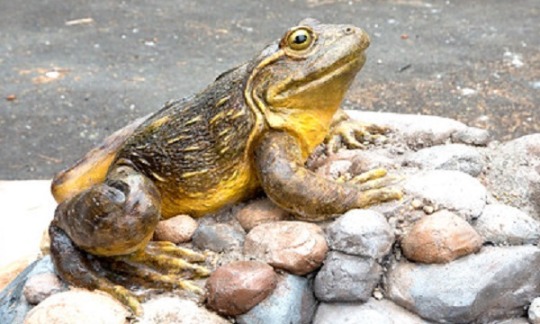
(Photo From San Francisco Zoo)
Conservation Status- Endangered
Habitat- Western Africa
Size (Weight/Length)- 3.1 kg; 30 cm
Diet- Insects; Fish; Crustaceans; Amphibians; Small mammals; Birds
Cool Facts- The goliath frog is the largest frog in the world, being as big as a tabby cat. Like all frogs, they start off life as a tadpole. And then they grow. And grow. And grow until they become a giant frog in their adulthood. These frogs eat anything and everything they can fit in their massive mouths. From rats, to other frogs, to even bats, their appatite is voracious. Due to their size, goliath frogs are poached for their meat and as exotic pets, leading to their endangered status.
Rating- 10/10 (Mr. Frog and Mr. Toad’s bigger cousin.)
#Animal of the day#Animals#Frogs#Saturday#August 21#Goliath frog#Biology#Science#Conservation#The more you know
75 notes
·
View notes
Photo
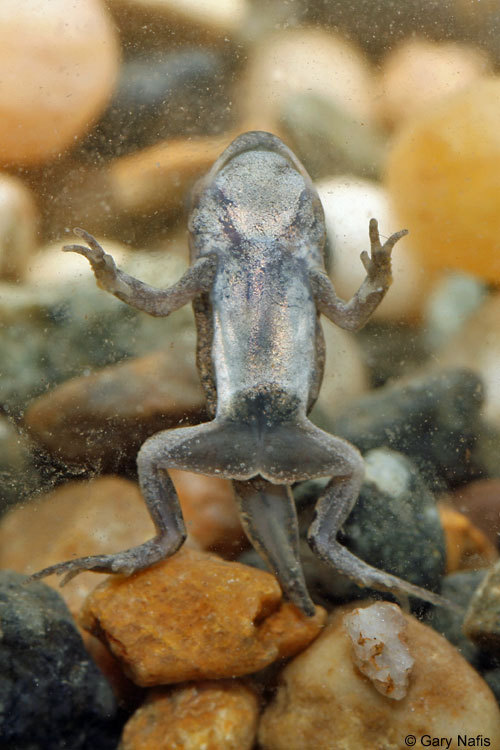

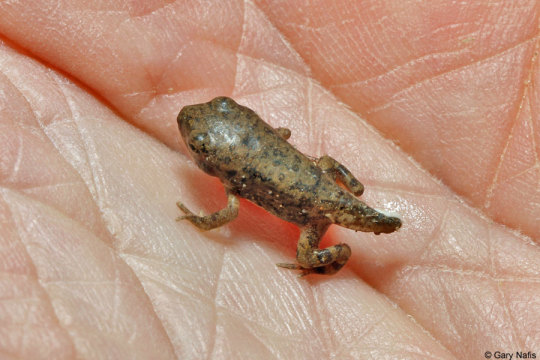
A young and still developing western Chihuahuan green toad [Anaxyrus debilis insidior] flashes their belly against the glass of their temporary holding tank. Newly morphed froglets of these species often remain at their nursery pools for much longer than other species, taking advantage of the available moisture and only dispersing once the pool has evaporated entirely. Images by Gary Nafis.
#western chihuahuan green toad#green toad#western green toad#toad#tadpole#toadlet#frogs#herps#amphibians#animals#nature
510 notes
·
View notes
Photo

#photographers of tumblr#photographers on tumblr#lensblr#photography#original photographers#bay area#norcal#california#may#spring#nature#aesthetic#tadpoles#western toad#animals#cute
3 notes
·
View notes
Video
youtube
Tadpoles: The Big Little Migration
Four years in the making, join my journey with the western toad in this short nature documentary.
For more visit: http://maxwelhohn.com
106 notes
·
View notes
Photo
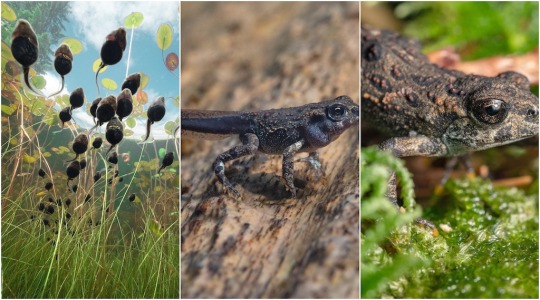
Documenting the Evolutionary Journey That Western Toad Tadpoles Must Take to Become Fully Grown
19 notes
·
View notes
Text



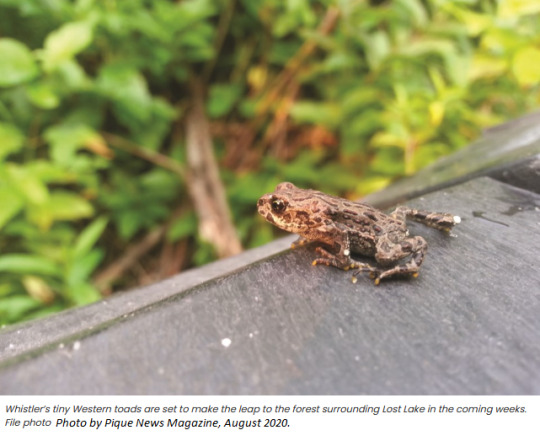




Megan Stewart. “Whistler builds ‘toadlet highway’ to aid migration of Western toad.” CTV News Vancouver. 4 August 2020:
Road closures are in effect near Lost Lake Park in Whistler to make way for the annual Western toad migration, and a new "toadlet highway" is in place to help the tiny, warty amphibians along their way.
While the road closures are temporary, the new infrastructure is permanent.
To ensure the success of the migration and aid the viability of the closely observed species, the Resort Municipality of Whistler has built an underpass below the Valley Trail as well as a boardwalk near the Blackcomb Creek Bridge at the intersection of Lost Lake Loop and Cedar Way. For the meantime, the municipality has also changed vehicle and shuttle access to the park and is asking all visitors to walk mindfully and dismount from bicycles to avoid crushing the dime-sized toadlets.
---
CTV News Vancouver. “Whistler warns visitors to look out for toads in Lost Lake Park.” 17 July 2019:
Each year, the municipality observes between 35,000 and 40,000 toads in Lost Lake Park. During peak hours, as many as 1,800 toadlets cross the park's beach trail each hour. Whistler has been monitoring the Lost Lake toad population since 2005. In addition to permanent features, including signage, fencing, and an underpass to protect the toad's breeding ground and tadpole habitat, the municipality puts up numerous temporary fences, signs, and boardwalks each year.
---
~~~ this user strongly dislikes hyper-commodified outdoor-recreation destination-tourist resorts like wh!stler ~~~
28 notes
·
View notes